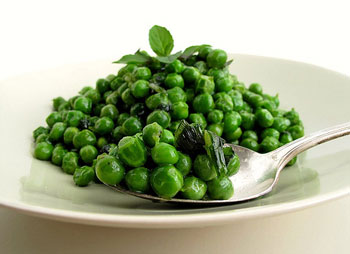 Peas with mint bring back so many fond memories of my travels in England. No matter where I went I always found peas with mint or mushy peas on every menu. A side of peas was always an accompaniment to fish and chips or roast beef. My love for peas as well as English food grew infinitely during my time there. It's funny, because as a kid I despised peas. Luckily as I grew older my tastes matured and now peas are one of my favorites.
Peas with mint bring back so many fond memories of my travels in England. No matter where I went I always found peas with mint or mushy peas on every menu. A side of peas was always an accompaniment to fish and chips or roast beef. My love for peas as well as English food grew infinitely during my time there. It's funny, because as a kid I despised peas. Luckily as I grew older my tastes matured and now peas are one of my favorites.
Once again I'm growing peas this summer. Peas are so easy to grow. You just start from seed and watch them climb up a fence. There's really no maintenance involved. I have two varieties: shelling peas and sugar snap peas, which can be eaten whole—pod and all. After picking six quarts of peas, I know I've got a lot of cooking to do to use up my haul. Some of my favorite recipes for peas include this creamy soup and this sugar snap pea stir-fry.
I love to serve a vegetable sauté with dinner, because it's quick and easy to prepare. With only five ingredients, this side dish of peas is perfect. Mint is a traditional herb with peas because it adds a fresh flavor. Don't be afraid to use it—a little goes a long way.

 Festive enough for a party, quick-and-easy for everyday cooking, skewered shrimp and cherry tomatoes are ready to serve in 30 minutes.
Festive enough for a party, quick-and-easy for everyday cooking, skewered shrimp and cherry tomatoes are ready to serve in 30 minutes. Memorial Day weekend has become synonymous with the beginning of summer and usually celebrated with barbecues, outdoor gatherings, or some kind of pre-summer fun.
Memorial Day weekend has become synonymous with the beginning of summer and usually celebrated with barbecues, outdoor gatherings, or some kind of pre-summer fun.

 Last week I hosted a cooking class with my friend, “J”. Each year we donate a cooking class to our school’s auction and this years theme was “Little Bites”. I wanted to not only come up with recipes that one could eat at a small cocktail party, but also, give ideas that could made in a few minutes, using pantry staples.
Last week I hosted a cooking class with my friend, “J”. Each year we donate a cooking class to our school’s auction and this years theme was “Little Bites”. I wanted to not only come up with recipes that one could eat at a small cocktail party, but also, give ideas that could made in a few minutes, using pantry staples.